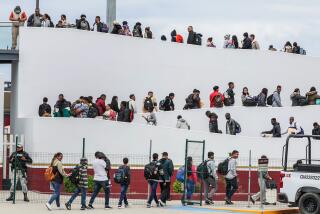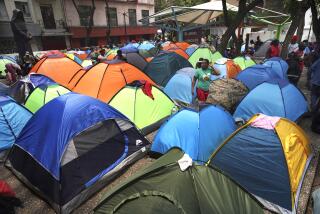Balseros Sail on a Tide of Desperation
MIAMI — As the flood tide of Cuban refugees continues to roll toward Florida, an emerging portrait of America’s newest emigres reveals that the typical Cuban rafter is a 28-year-old man with a 10th-grade education who does not speak English and has a death-defying certainty that his chances for a happy life under the regime of Fidel Castro are zero.
“These are the risk-takers, willing to sacrifice today . . . to have a better tomorrow,” said Msgr. Bryan O. Walsh, executive director of Miami’s Catholic Community Service. “They make the best possible additions to a free enterprise system.”
Based on interviews with dozens of refugees and social service officials and some preliminary government statistics, those who risk the perilous trip across the Florida Straits come into focus as a cross-section of a communist society bereft of promise and opportunity for laborers and professionals alike.
From single men to intact families with infants, what the Cuban balseros share, according to observers here, is a hopelessness so deep that risking sharks and drowning seems better than staying put. “They are not pursuing the American dream as much as they are fleeing the Cuban nightmare,” said Miami sociologist Juan Clark. “This is an exodus of people desperate to leave.”
This desperation distinguishes the rafters from some previous immigrants and likely will color their experience in the United States for some time to come.
Unlike the waves of Europeans who came to this country seeking a better life in the late 19th Century, many of the Cubans now arriving may not have spent years carefully planning for the opportunity ahead. And as products of the communist revolution, many of the Cubans also have only the vaguest idea of how a free-market society works and how to live in one.
Thus they may face an extended period of confusion and adjustment.
But the balseros, or rafters , may have some special advantages. About 85% to 90% of the refugees in one group processed by the government claimed relatives in this country, who in many cases can provide a place to stay, leads on jobs and crucial help in getting off to a good start. By contrast, many migrants streaming across the southern border of the United States go it alone and struggle to get a foothold with subsistence work.
And as much as any migrants have, the newest Cuban emigres have demonstrated a fierce desire to overcome adversity.
“These are people with a high level of initiative, which is considered a handicap in Cuba,” said Clark, a professor at Miami-Dade Community College. Those who choose to make the dangerous journey are those most stifled by the totalitarian system there “because using initiative there makes you a criminal. It’s a crime to be successful.”
While more than 12,000 Cubans picked up in the last week are now either held in a detention camp at the U.S. naval base at Guantanamo, Cuba, or headed there, this year about 7,500 others beat the Aug. 20 cutoff and were permitted to enter the country.
Among them:
* Alberto Gomez, 30, a factory worker who left his wife and daughter in Guanabo and climbed aboard a flimsy inner-tube raft for a trip that he said “terrified me to tears.” But he vowed: “Here I will work hard, and within a year reclaim my family.”
* Rosa Zambrana Aleman, 33, who spent eight days at sea with her 12-year-old daughter and 26 others from her hometown of Sagua la Grande, 200 miles east of Havana. “ Mar y cielo, nada mas ,” she said--nothing but sea and sky. Now, with no family in the United States, she does not know where she will end up. “Whatever God wants,” she said.
* Orlando Pena, 36, a pulp mill worker, who along with his brother, Ovidio, and their father, also named Orlando, said goodby to his mother in a Pinar del Rio hospital where she was having an ovarian cyst removed. “She begged us not to go,” he said. “But there was no other way.” He, his father and brother have the promise of work aboard a shrimp boat in Key West.
Although from the same country, the balseros seem to have remarkably little in common with those in the last mass flight from Cuba, the Mariel boat lift, according to those who work with them.
“They are not criminals, they are not insane or sick--which is what everybody’s afraid of,” said Roseann Micallef, director of the Church World Service refugee program. “This is no Mariel.” (Officials have noted, however, that some recently paroled convicts are among the latest wave of refugees.)
Indeed, since the exodus from Cuba boiled up into a crisis three weeks ago, South Florida has been haunted by the specter of Mariel, the chaotic 1980 boat lift in which more that 125,000 Cubans arrived here in five months. Among those arrivals were about 5,000 criminals and mental patients who were forced onto American boats that had traveled to Cuba to pick up relatives. Although Castro has threatened to open his ports to U.S. vessels, the Clinton Administration’s firm threat to prosecute American residents who travel to Cuba has so far prevented a repeat of a Mariel-style flotilla.
Among the balseros , a prime characteristic seems to be their physical condition.
“People are really very healthy,” said Msgr. Walsh, a veteran of 35 years of refugee affairs in Miami. “Most are so skinny we didn’t have clothes to fit them--but (they are) healthy.”
According to figures from the U.S. Justice Department’s Community Relations Service, which oversees refugee resettlement, 560 Cubans were processed in the week ending Aug. 16. Of those, 80% were male and, of those, 60% were single. In the group were 56 children under 18 years old.
Cuban migration to the United States, and especially to South Florida, has been a constant almost from the first days of Castro’s rule, which began in January, 1959. But until now, there have been two major exoduses: first in 1960 and 1961, when thousands of Cuba’s middle class, fearing Castro’s turn to communism, fled to Miami by air, and again with Mariel in 1980.
The Mariel boat lift brought to South Florida a more representative sampling of the Cuban population: younger, less-educated, darker skinned. Unlike earlier refugees, most had grown up under communism and many here--Cubans and non-Cubans alike--feared that the Mariel arrivals lacked a well-defined work ethic. That fear has been proven to be largely unfounded.
The new arrivals are expected to follow that pattern, moving soon into the productive economy.
“Cubans are advantaged in two ways: with a large, reasonably prosperous enclave to help them get a foothold and, as refugees, they are entitled to federal benefits,” said Michael Fix, director of immigrant policy for the Urban Institute, a Washington think tank. “Together, that may explain why Cubans have been so successful here, especially economically.”
Many of the new arrivals already have connected with the network. Liduvina Lugones, for example, received a call one recent afternoon from a refugee worker in Key West who told her: “Your nephew Rodney is here. He just rafted in. Can you take him?”
Lugones, a U.S. resident for 25 years, had never met Rodney Herrera, her brother’s son. “Now I am trying to help him find a job, get him settled somewhere, let him start a life here,” she said.
Leslie Bryon, a counselor with Catholic Community Service and a Cuban emigre himself, said that people such as Herrera often find work at Miami International Airport, where men get hired as baggage handlers, and women clean planes between flights. The pay is minimum wage, $4.50 an hour.
To most Cubans, used to making the peso equivalent of $1 or $2 a month, that seems like a fortune.
“I tell them to study English and I give them a list of night school classes too,” said Bryon. (In Greater Miami, with a population that is about 50% Latino, a lack of English is often not a serious handicap, however. Spanish is spoken everywhere.)
Those without family in South Florida are often put up in small, local motels in Miami’s Little Havana section. For example, at the San Juan Motel on Southwest 8th Street, known as Calle Ocho, balseros occupied 15 of the 22 rooms here.
Before long they step out into their new world.
Standing in the hallway of a Little Havana resettlement agency, Alberto Gomez looked small and bewildered as he struggled to understand what he must do to obtain a Social Security card, food stamps and a physical exam. He spent 2 1/2 days at sea before the Coast Guard picked him and seven others up off the Florida Keys.
He is staying now with a distant cousin, sleeping behind a partition in the cousin’s upholstery shop. He recalled the raft trip: “I only thought of arriving. I didn’t think of my family. Only the hope of getting here.”
Asked about his family in Guanabo, Gomez opened a rolled up handbook on Florida’s driving laws and pulled out a picture of his 6-year-old daughter at a birthday party. Tears welled in his eyes and he turned away.
“We had talked about my going for a long time,” he said finally. “The situation there was bad. One year. In one year I will have the money to get them here too.”
The Risk-Takers
The emerging portrait of the Cuban refugees, based on early interview with social service workers and the government:
Profile
Male: About 80%
Single: More than half
Under 18: About 10%
Typical rafter: A 28-year-old man with a 10th-grade education who does not speak English.
Quote
“They are not criminals, they are not insane or sick--which is what everybody’s afraid of. This is no Mariel (the last mass Cuban boat lift).”
--Roseann Micallef, refugee program director
More to Read
Sign up for Essential California
The most important California stories and recommendations in your inbox every morning.
You may occasionally receive promotional content from the Los Angeles Times.










